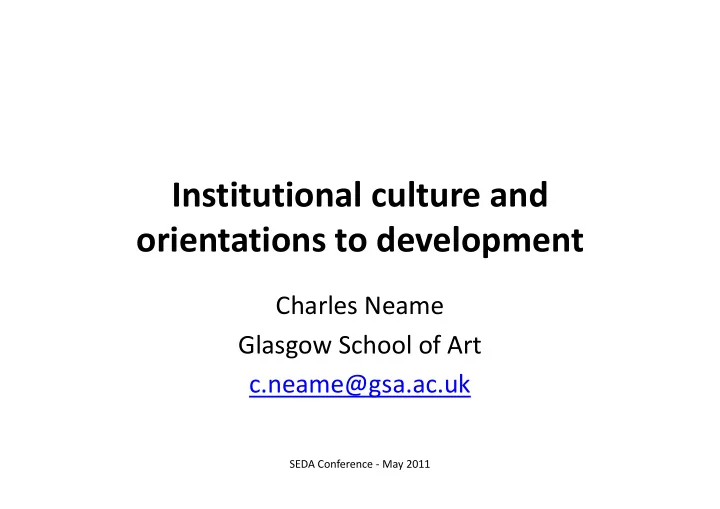

Institutional culture and orientations to development Charles Neame Glasgow School of Art c.neame@gsa.ac.uk SEDA Conference - May 2011
Outline... 1. My take on the relationship between: – the educational developer and institutional culture & context A simple model – An example case 2. Your analysis of the model: – Application to your own experience and context 3. Sharing thoughts: Is it relevant? – – Innovation and/or weaknesses? – Room for improvement? SEDA Conference - May 2011
Background • Action research at an English HEI • Cross-school/discipline group – PDP: Forms and perspectives – Differences between schools, departments: • How to engage the unengaged? – The educational development problem: • Different “communities” • Different cultures • Different approaches SEDA Conference - May 2011
The questions I asked... What model: 1. explains the process of “ engaging the unengaged ”? 2. can guide the manipulation of educational development relationships, in a range of different situations? SEDA Conference - May 2011
Starting point • “Orientations to educational development” (Ray Land, 2004) • 12 ‘orientations’ based on in depth interviews with educational developers SEDA Conference - May 2011
12 orientations 1. Managerial 7. Reflective Practitioner 2. Political - 8. Professional strategic Competence 3. Opportunist 9. Internal consultant 4. Entrepreneurial 10.Modeller-broker 5. Researcher 11.Interpretive- hermeneutic 6. Romantic 12.Provocateur SEDA Conference - May 2011
What are ‘orientations’? • Orientations represent: – Preferences? (i.e. modes of professional operation) – Strategic responses? (i.e. professional choices made to suit context) • Partly: – Intuition – Comfort zone – Planned response SEDA Conference - May 2011
Application of the ‘orientations’ framework • Enlightening insight, but complex? • Review suggested a simpler version: – Two essential forms • Interventionist • Democratic – Dependent on • Context & community • Stage of development/innovation SEDA Conference - May 2011
A model of community-developer relationships SEDA Conference - May 2011
Example (Phase 1) • One School not engaged in action research • All development seen as transactional/formal • Task: – Find and ‘recruit’ one ‘susceptible’ & influential academic (Theresa) through formal engagement – Work collaboratively with Theresa to identify value in new PDP practice – Theresa mediates with others in school SEDA Conference - May 2011
Example (Phase 2) • Senior sceptic (Chris) agrees to discuss PDP • Formal basis for trial (with rules) agreed • Once trial underway, relationship becomes collaborative: Chris Me v v v Chris’s course team SEDA Conference - May 2011
Change of orientation • Throughout the process: – Switching between ‘intervention’ & ‘democracy’ – Depending on: • Stage of engagement/development • Perspective of staff involved SEDA Conference - May 2011
SEDA Conference - May 2011
Your turn... • Does this model help: – Explain how spreading innovation can work? – Plan the sharing of new ideas? • Do you use these concepts already: – Explicitly? – Implicitly/intuitively? • Can you provide examples? • Can we make the model more useful? SEDA Conference - May 2011
Key References Land, R. (2004). Educational development: discourse, identity and practice . SRHE & Open University Press. Maidenhead Fielding, M., Bragg, S., Craig, J., Cunningham, I., Eraut, M., Gillinson, S., Horne, M. Robinson, C., Thorp, J. (2005). Factors influencing the transfer of good practice . DfES. Nottingham. SEDA Conference - May 2011
Recommend
More recommend